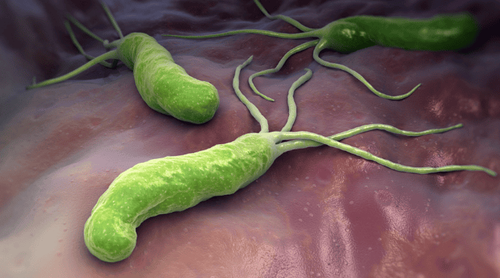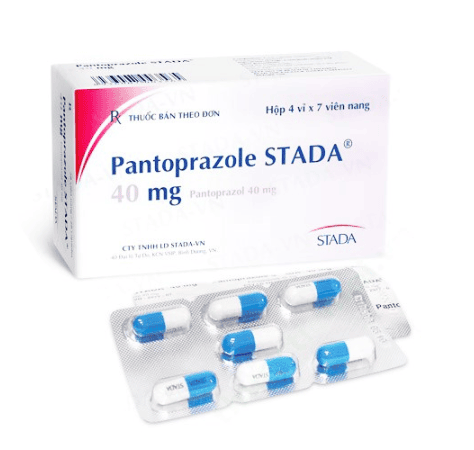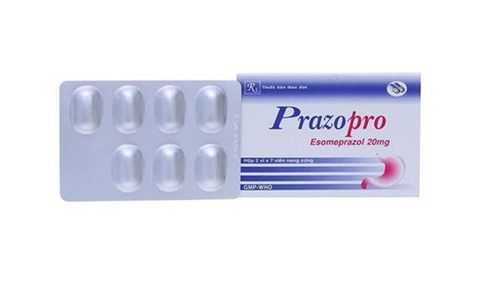This is an automatically translated article.
Article written by Master - Doctor Mai Vien Phuong - Head of Gastrointestinal Endoscopy Unit - Department of Medical Examination and Internal Medicine - Vinmec Central Park International General Hospital.
Once in the gastrointestinal tract, Helicobacter pylori is associated with inflammatory bowel disease, gastroesophageal reflux disease, nonalcoholic fatty liver disease, hepatocellular carcinoma, gallstones, and cholecystitis. Lower serum iron and vitamin B12 concentrations have also been found in patients with H. pylori infection, leading to the development of ischemia in some.
1. Overview
Helicobacter pylori is a bacterium that infects the stomach environment and has been linked to gastrointestinal diseases, including peptic ulcer and gastric adenocarcinoma. However, since the 80s of the last century, the relationship between this type of infection and extra-gastric manifestations has also been studied; such as inflammatory bowel disease , iron and B12 deficiency , nonalcoholic fatty liver disease , hepatocellular carcinoma , multiple sclerosis , Alzheimer's disease , Parkinson's disease and Guillain-Barré syndrome .
2. Some basic transmission routes of Helicobacter pylori
Helicobacter pylori (H. pylori) is a gram-negative bacterium that lives in the stomach environment of 60.3% of the world's population, and the prevalence of this bacterium is especially high in countries with socio-economic conditions. worse, exceeding 80% in some regions of the world. This phenomenon occurs in part due to the unsatisfactory basic sanitation and high population numbers observed in many less developed countries, which are favorable “scenarios” for transmissible transmission. oral and fecal route of H. pylori.
Another route of transmission of this pathogen that is currently being discussed is the sexual route, as H. pylori infected individuals (who have a positive sexual partner) have a higher infection rate than the control group. It is well established that this microorganism is mainly involved in the development of gastrointestinal disorders, prominently peptic ulcer, mucosal connective tissue lymphoma and carcinoma. gastric glandular tissue. However, since the 1980s, there has been increasing evidence to suggest such infection with some extragastric manifestations.

3. Helicobacter pylori infection appears to influence the onset and severity of disease from multiple organ systems
In this context, H. pylori infection is thought to influence the onset and severity of disease from a variety of organ systems, acting as a risk factor for several disorders but also playing a role acts as a protective agent against certain conditions.
H. pylori infection appears to be associated with inflammatory bowel disease (IBD), gastroesophageal reflux disease (GERD), non-alcoholic fatty liver disease (NAFLD), hepatocellular carcinoma, gallstones, and gallstones. cholecystitis . In addition, serum iron and vitamin B12 deficiency is thought to be exacerbated or even, caused by H. pylori itself. In addition, ocular, dermatological, metabolic, cardiovascular, and neurological diseases are also associated with this microorganism. Extragastric manifestations of Helicobacter pylori and possible pathogenesis of these diseases:
| Biểu hiện ngoài dạ dày | Các cơ chế của bệnh lý được đề xuất là có mối tương quan với nhiễm khuẩn H. pylori |
|---|---|
| Bệnh dị ứng | Giả thuyết vệ sinh. |
| Bệnh Alzheimer | Thiếu vitamin B12 làm tăng nồng độ homocysteine. |
| Sự tăng phosphoryl hóa bất thường của protein TAU do nhiễm H. pylori. | |
| Đa hình ApoE. | |
| Bệnh hen suyễn | Ngăn chặn phản ứng dị ứng qua trung gian Th-2. |
| Xơ vữa động mạch và nhồi máu cơ tim | Kích thích sản xuất bọt bên trong các đại thực bào, góp phần làm phóng đại mảng xơ vữa động mạch và rối loạn chức năng động mạch. |
| Thiếu B12 | Vẫn còn đang được làm rõ nhưng đã được chứng minh là không phụ thuộc vào chứng teo dạ dày và chảy máu làm giảm khả năng hấp thụ qua chế độ ăn uống của bệnh nhân. |
| Sỏi mật | Sự hiện diện của mật bị nhiễm H. pylori |
| Bệnh động mạch vành / cứng động mạch hệ thống | Tăng mức độ homocysteine. |
| Bệnh trào ngược dạ dày thực quản | Tăng tiết dịch vị dạ dày. |
| Đái tháo đường | Tăng sản xuất cytokine; quá trình phosphoryl hóa dư lượng serine từ chất nền của thụ thể insulin. |
| Ung thư biểu mô gan | Quá trình viêm, xơ hóa và hậu quả là hoại tử. |
| Ban xuất huyết giảm tiểu cầu vô căn (ITP) | CagA có thể kích thích sự tổng hợp các kháng thể kháng CagA phản ứng chéo với các kháng nguyên bề mặt tiểu cầu gây ra ITP. |
| Bệnh viêm ruột | Giảm viêm ruột thông qua giải phóng IL-18 và phát triển các tế bào T điều hòa. |
| Protein kích hoạt bạch cầu trung tính giảm viêm thông qua thụ thể Toll-like 2 và kích thích IL-10. | |
| Thiếu máu do thiếu sắt | Vẫn còn đang được làm rõ, nhưng đã được chứng minh là không phụ thuộc vào chứng teo dạ dày và chảy máu làm giảm khả năng hấp thụ qua chế độ ăn uống của bệnh nhân. |
| Mối liên quan với rối loạn tăng trưởng ở trẻ em. | |
| Bệnh đa xơ cứng | Giả thuyết vệ sinh. |
| Sự cảm ứng ức chế của H. pylori đối với phản ứng miễn dịch Th1 và Th17. | |
| Bệnh gan nhiễm mỡ không do rượu | H. pylori gây ra kháng insulin. |
| Giảm sản xuất adiponectin. | |
| Viêm gan. | |
| Biểu hiện nhãn khoa | Tình trạng viêm nhiễm toàn thân; tăng căng thẳng oxy hóa; rối loạn chức năng ty thể; thiệt hại cho DNA. |
| Bệnh Parkinson | Tăng tổng hợp 1-methyl-4-phenyl-1,2,36-tetrahydropyridine. |
| Giảm hấp thụ levodopa. |

Orange is a risk indicator for Helicobacter pylori (H. pylori) infection. The blue color represents the protective association of H. pylori bacteria. Gray is the expression with dichotomous association.
4. Conclusion
Although H. pylori infection is often associated with gastric manifestations, increasing evidence is drawing attention to its role in extragastric diseases. Understanding how this bacterium affects extragastroduodenal disorders may shed light on unknowns in their pathophysiology and may shed new light on therapeutic targets in the management of gastrointestinal disorders. control these conditions.
Please follow the website: Vinmec.com regularly to update many other useful information.
Please dial HOTLINE for more information or register for an appointment HERE. Download MyVinmec app to make appointments faster and to manage your bookings easily.
References: luanvanyhoc.com, benhvienthienmy.com, Khoay.tvu.edu.vn, vi.wikiqube.netReferences: Santos MLC, de Brito BB, da Silva FAF, Sampaio MM, Marques HS, Oliveira e Silva N, de Magalhaes Queiroz DM, de Melo FF. Helicobacter pylori infection: Beyond gastric manifestations. World J Gastroenterol 2020; 26(28): 4076-4093 [PMID: 32821071 DOI: 10.3748/wjg.v26.i28.4076]














